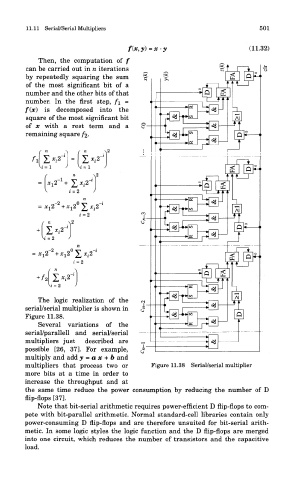Page 516 - DSP Integrated Circuits
P. 516
11.11 Serial/Serial Multipliers 501
Then, the computation of f
can be carried out in n iterations
by repeatedly squaring the sum
of the most significant bit of a
number and the other bits of that
number. In the first step, f\ =
f(x) is decomposed into the
square of the most significant bit
of x with a rest term and a
remaining square /2-
The logic realization of the
serial/serial multiplier is shown in
Figure 11.38.
Several variations of the
serial/parallell and serial/serial
multipliers just described are
possible [26, 37]. For example,
multiply and add y = a x + 6 and
multipliers that process two or Figure 11.38 Serial/serial multiplier
more bits at a time in order to
increase the throughput and at
the same time reduce the power consumption by reducing the number of D
flip-flops [37].
Note that bit-serial arithmetic requires power-efficient D flip-flops to com-
pete with bit-parallel arithmetic. Normal standard-cell libraries contain only
power-consuming D flip-flops and are therefore unsuited for bit-serial arith-
metic. In some logic styles the logic function and the D flip-flops are merged
into one circuit, which reduces the number of transistors and the capacitive
load.

